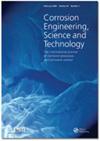双相不锈钢在氯化物溶液中腐蚀时的形貌和伏特电位分布的数值分析
IF 1.5
4区 材料科学
Q4 MATERIALS SCIENCE, MULTIDISCIPLINARY
Corrosion Engineering, Science and Technology
Pub Date : 2022-08-16
DOI:10.1080/1478422X.2022.2111039
引用次数: 1
摘要
双相不锈钢(DSS)的腐蚀通常始于特定的相,导致水环境中的优先相溶解。尽管扫描开尔文探针力显微镜(SKPFM)可以在微观甚至纳米尺度上表征相腐蚀,但传统的数据处理方法不足以分析大量数据以获得机理信息,有时甚至会导致对腐蚀演化的误解。在这里,我们利用均方根、功率谱密度和分形评估来分析SKPFM在氯化物溶液中2205 DSS腐蚀过程中获得的随时间变化的地形和电压电位结果。DSS的腐蚀在初始阶段优先发生在铁素体相中和铁素体/奥氏体边界处。随着时间的增加,腐蚀从最初的电流机制转变为传质控制。通过使用适当的数值工具,Volta电位结果比地形剖面更能深入分析腐蚀。本文章由计算机程序翻译,如有差异,请以英文原文为准。
Numerical analysis of topographic and Volta potential profiles during corrosion of duplex stainless steel in chloride solution
ABSTRACT Corrosion of duplex stainless steels (DSS) usually initiates at a specific phase, causing preferential phase-dissolution in aqueous environments. Although the scanning Kelvin probe force microscopy (SKPFM) can characterise the phase-corrosion at a micro- or even nanoscale, conventional data-processing methods are insufficient to analyse massive data to derive mechanistic information, and sometimes, even cause a misunderstanding of corrosion evolution. Here we utilised root mean square, power spectral density and fractal evaluations to analyse the time-dependent topographic and Volta potential results obtained by SKPFM during corrosion progression of 2205 DSS in a chloride solution. Corrosion of the DSS preferentially occurs in the ferrite phase and at the ferrite/austenite boundaries in the initial stage. The corrosion changes from the initial galvanic mechanism to mass transfer control with increased time. By using proper numerical tools, the Volta potential results are more insightful of analysing corrosion than the topographic profiles.
求助全文
通过发布文献求助,成功后即可免费获取论文全文。
去求助
来源期刊

Corrosion Engineering, Science and Technology
工程技术-材料科学:综合
CiteScore
3.20
自引率
5.60%
发文量
58
审稿时长
3.4 months
期刊介绍:
Corrosion Engineering, Science and Technology provides broad international coverage of research and practice in corrosion processes and corrosion control. Peer-reviewed contributions address all aspects of corrosion engineering and corrosion science; there is strong emphasis on effective design and materials selection to combat corrosion and the journal carries failure case studies to further knowledge in these areas.
 求助内容:
求助内容: 应助结果提醒方式:
应助结果提醒方式:


